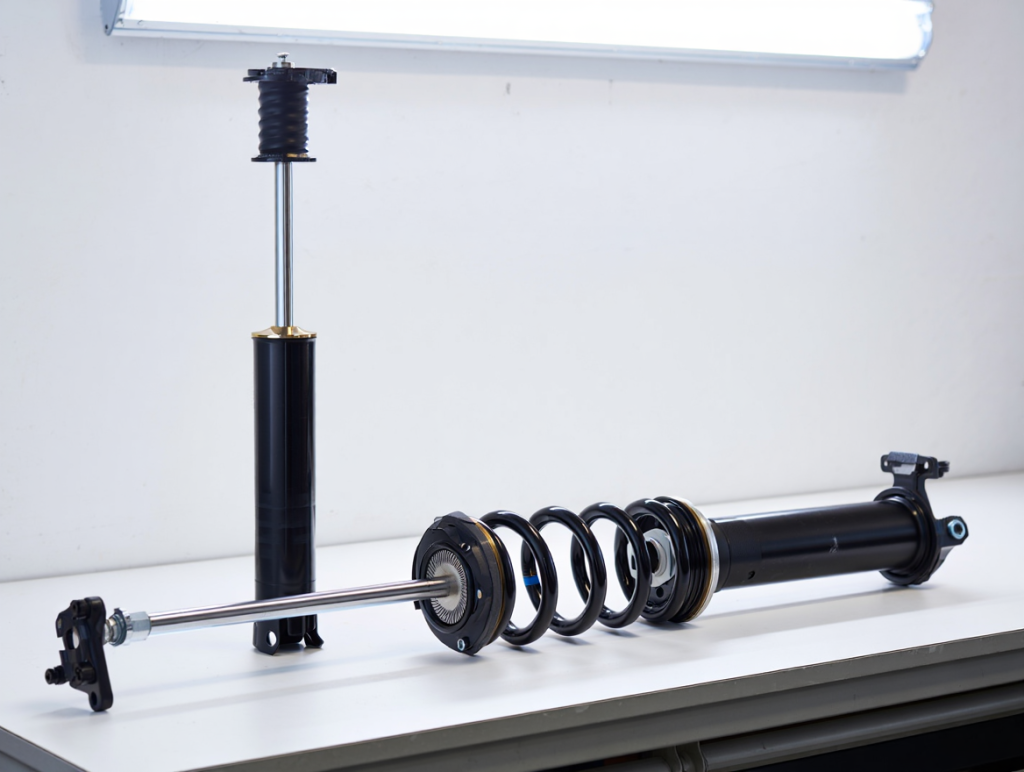Your vehicle’s suspension system is more than just springs and tires—it’s the unsung hero that keeps your car stable, comfortable, and safe. Two critical components that often confuse car owners are shocks (shock absorbers) and struts. While both control vehicle motion over bumps and dips, their design, function, and maintenance requirements differ significantly.
Failing to understand these differences can lead to poor handling, uneven tire wear, reduced braking efficiency, and expensive repairs. This guide explains everything you need to know about shocks and struts, including how they work, lifespan, replacement signs, costs, OEM vs aftermarket considerations, and practical tips to extend your suspension life.
Understanding Vehicle Suspension
Role of Shocks and Struts
The suspension system ensures your car’s wheels stay in contact with the road while absorbing bumps and vibrations. Shocks and struts play a pivotal role in controlling spring motion, which affects:
- Steering response and stability
- Braking efficiency and stopping distance
- Cornering performance and body roll
A worn or failing suspension component can compromise vehicle control, leading to unsafe driving conditions.
Types of Suspension Systems
Different suspension designs influence which components are used:
- MacPherson strut: Combines a shock absorber and coil spring in one assembly; commonly used in front-wheel-drive cars.
- Double wishbone: Found in high-performance or luxury vehicles; may use separate shocks and springs.
- Multi-link: Offers independent wheel movement, often combining shocks and struts for optimal ride and handling.
Understanding your vehicle’s suspension type is crucial when diagnosing ride issues or performing maintenance.
What Are Shocks?
Construction and Features
Shock absorbers are hydraulic or gas-filled cylinders that dampen the compression and rebound of the vehicle’s springs. They control motion but do not support the vehicle’s weight or alignment.
- Hydraulic shocks: Use fluid to resist piston movement, converting kinetic energy into heat.
- Gas-charged shocks: Nitrogen gas reduces foaming and improves responsiveness.
- Mounting: Typically attaches to the chassis and lower control arm.
Shocks are generally simpler and cheaper to replace than struts, but they play a vital role in ride comfort and vehicle safety.
Signs a Worn Shock
Worn shocks show various symptoms:
- Excessive bouncing over bumps or dips
- Nose-diving during braking
- Increased stopping distance
- Uneven tire wear
- Fluid leaks on the shock body
Example: A 2012 Ford F-150 with worn rear shocks may have noticeable bed bouncing after hitting potholes, affecting passenger comfort and cargo stability.
Pros and Cons
Pros:
- Smooth ride and vibration control
- Lower replacement cost compared to struts
- Can replace individually or in pairs
Cons:
- Only controls motion, doesn’t support suspension structure
- Wears faster under rough driving conditions
What Are Struts?
Construction and Features
Struts integrate a shock absorber, coil spring, and top mount in a single assembly. They dampen motion and provide structural support for the suspension, affecting steering geometry and alignment.
- Components: Shock, coil spring, top mount, bearing plate
- Functions: Absorb shocks, support weight, maintain alignment, reduce wear on other components
Signs a Worn Strut
Strut failure affects both comfort and vehicle control:
- Vehicle sagging or uneven ride height
- Uneven tire wear
- Body roll or leaning during cornering
- Clunking or knocking noises over bumps
- Reduced braking efficiency
Example: A 2016 Honda Accord with worn front struts may feel unstable during highway lane changes, with noticeable body roll and uneven tire wear.
Pros and Cons
Pros:
- Provides structural support
- Affects alignment and tire wear
- Combines multiple components in one unit
Cons:
- Higher replacement cost and labor-intensive
- Often replaced in pairs for balanced handling
Shocks vs. Struts: Key Differences
Functional Differences
| Feature | Shock Absorber | Strut |
| Controls motion | Yes | Yes |
| Supports vehicle weight | No | Yes |
| Part of alignment | No | Yes |
| Includes spring | No | Yes |
| Replacement complexity | Easy | Moderate/High |
Shocks mainly control spring motion, while struts control motion and maintain structural integrity, making strut replacement more critical for vehicle alignment.
Lifespan Comparison
- Shocks: 50,000–100,000 miles
- Struts: 50,000–75,000 miles
Severe driving conditions, heavy loads, or rough terrain can shorten lifespan. Regular inspections prevent unexpected failures.
Replacement Costs
| Component | Parts | Labor | Total |
| Shock | $50–$150 | $100–$200 | $150–$350 |
| Strut | $100–$300 | $200–$400 | $300–$700 |
OEM vs Aftermarket: OEM ensures fit and warranty compliance; reputable aftermarket brands like Monroe, KYB, or Bilstein provide high-quality alternatives at lower prices.
Technical Insights
How Driving Habits Affect Suspension
- Aggressive cornering or braking accelerates shock/strut wear
- Off-road driving increases risk of bent struts or leaking shocks
- Overloading beyond rated capacity stresses springs and mounts
DIY Inspection Tips
- Look for oil leaks on shocks/struts
- Check for sagging or uneven ride height
- Bounce each corner: excessive rebound indicates worn shocks
- Inspect tires for cupping or feathering
How Shocks/Struts Affect Other Systems
- Tires: Worn components cause uneven wear
- Brakes: Increased stopping distance due to instability
- Steering: Loose or worn struts affect responsiveness
Common Mistakes Car Owners Make
- Replacing only one side → uneven handling
- Ignoring gradual ride changes → worsens over time
- Confusing symptoms with tire/alignment issues → misdiagnosis
- Using cheap aftermarket parts → poor ride quality, early failure
- Neglecting mounts/bushings → can mimic shock/strut failure
Practical Tips for Longer Suspension Life
- Inspect shocks/struts during routine maintenance
- Avoid overloading your vehicle
- Drive cautiously on rough terrain
- Maintain proper tire inflation
- Replace leaking or worn mounts/bushings promptly
- Choose performance or heavy-duty shocks/struts if towing frequently
Real-World Examples
- Toyota Camry (2018): OEM struts replaced at 60,000 miles due to sagging; KYB aftermarket restored comfort and alignment.
- Ford F-150 (2012): Rear shocks replaced at 80,000 miles; reduced bouncing and improved bed stability.
- Honda Civic (2016): Worn front struts caused tire feathering; full front replacement corrected alignment and road noise.
Conclusion
Shocks and struts are both essential to vehicle safety, handling, and ride comfort—but they serve different roles. Shocks control spring motion, while struts combine damping with structural support and alignment influence.
Timely replacement prevents tire damage, instability, and braking issues. Pairing OEM or trusted aftermarket parts with regular inspections, cautious driving, and maintenance extends suspension life. Always consult a professional for replacement and alignment to maintain performance and safety.
FAQs
Can I drive with worn shocks or struts?
Driving with worn suspension is risky. It reduces stability, increases braking distance, and causes uneven tire wear. Short trips may be manageable, but prolonged use can damage tires, bushings, and mounts. Replace components promptly to ensure safety, handling, and ride comfort.
How often should shocks or struts be replaced?
Shocks: 50,000–100,000 miles; struts: 50,000–75,000 miles. Harsh conditions, heavy loads, and off-road driving may require earlier replacement. Regular inspections during tire rotations or oil changes help detect wear early and prevent safety or handling issues.
Can I replace shocks without replacing struts?
Yes, shocks can be replaced independently if struts are healthy. Replacing in pairs is recommended to maintain balanced handling. Struts are more complex and usually replaced in pairs to ensure suspension geometry and proper alignment.
Do struts affect alignment?
Yes. Struts support suspension geometry, affecting camber, caster, and toe. Worn or replaced struts often require alignment to prevent uneven tire wear and maintain safe handling.
Is it worth upgrading to performance shocks or struts?
For towing, heavy loads, or spirited driving, performance shocks/struts improve handling, reduce body roll, and maintain stability. Standard shocks/struts are sufficient for daily commuting but may underperform under aggressive or heavy-duty conditions.
How do I know if my struts are OEM or aftermarket?
Check part numbers or branding on the strut body. OEM matches manufacturer specifications exactly. Aftermarket brands (Monroe, KYB, Bilstein) are reliable alternatives. Always verify compatibility using your VIN or consult a trusted mechanic.

Benjamin Grey is an automotive engineer and writer at Car Parts Advisor. With years of experience in the automotive industry, he shares expert advice on car parts, maintenance, and repairs to help car owners keep their vehicles running smoothly.





